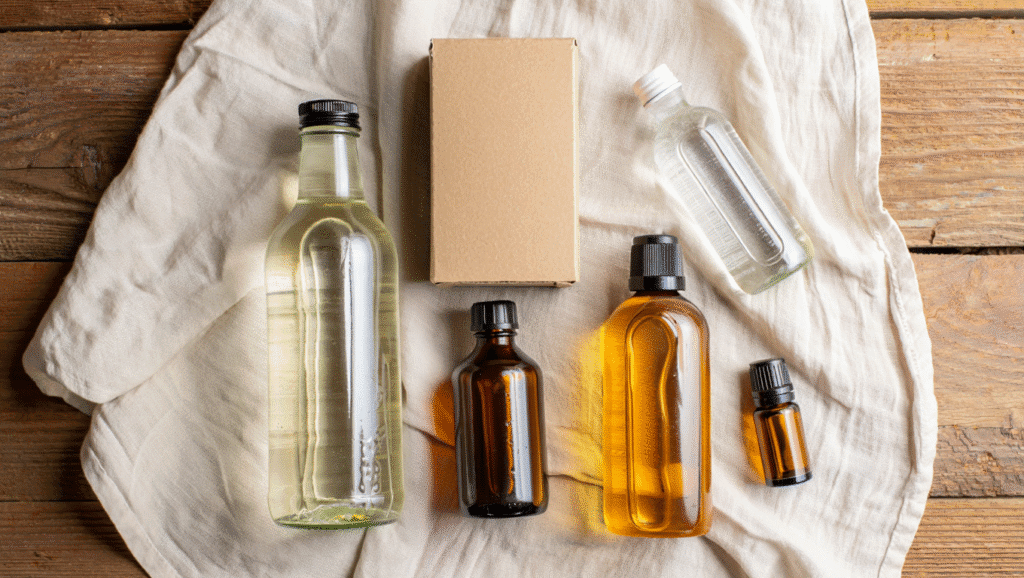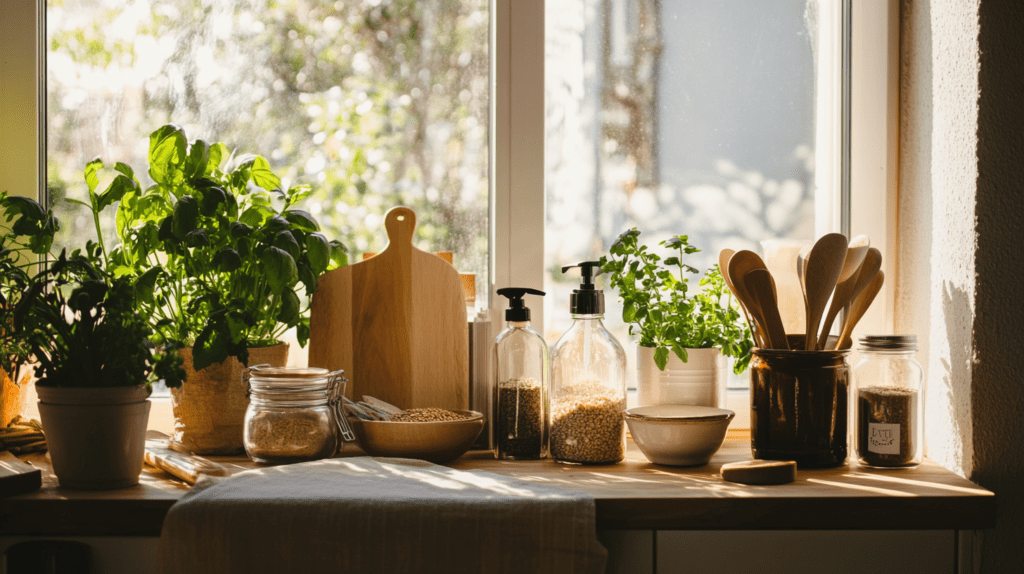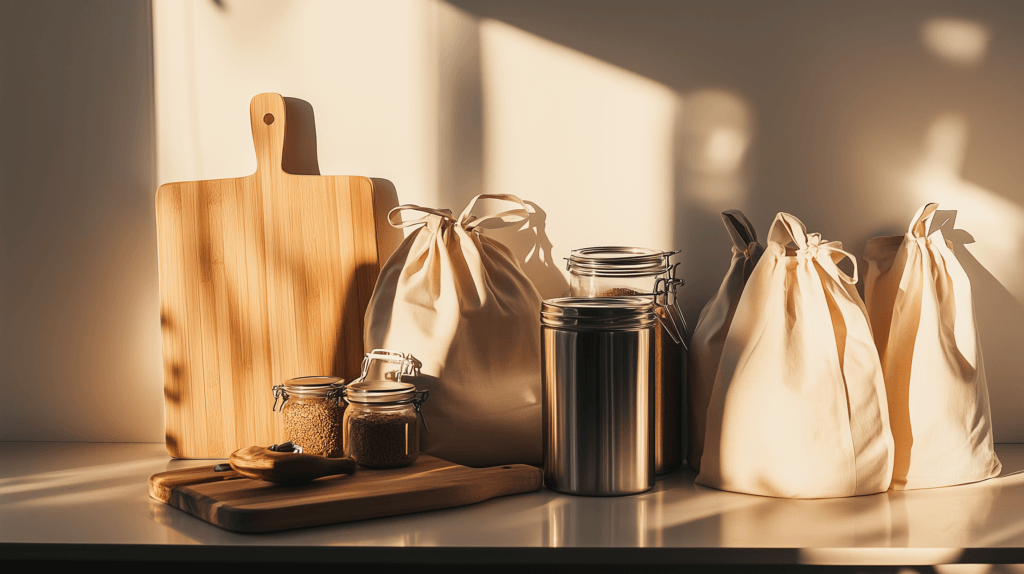This post may contain affiliate links, including those from Amazon Associates. If you make a purchase through these links, I may earn a commission at no additional cost to you. Learn more about our affiliate policy.
When I first embarked on my journey toward a natural home, one of the most overwhelming areas was cleaning.
Like many, I believed that keeping my home clean and germ-free meant shelves packed with specialty cleaners, each promising incredible results. But each one was also packed with synthetic fragrances and harsh chemicals, often leaving me with headaches and irritated skin.
Maybe you’re standing exactly where I was, confused, skeptical, and weary of greenwashing. Perhaps you’ve looked at DIY recipes and wondered, “Can something as simple as vinegar or baking soda truly keep my home clean and safe?”
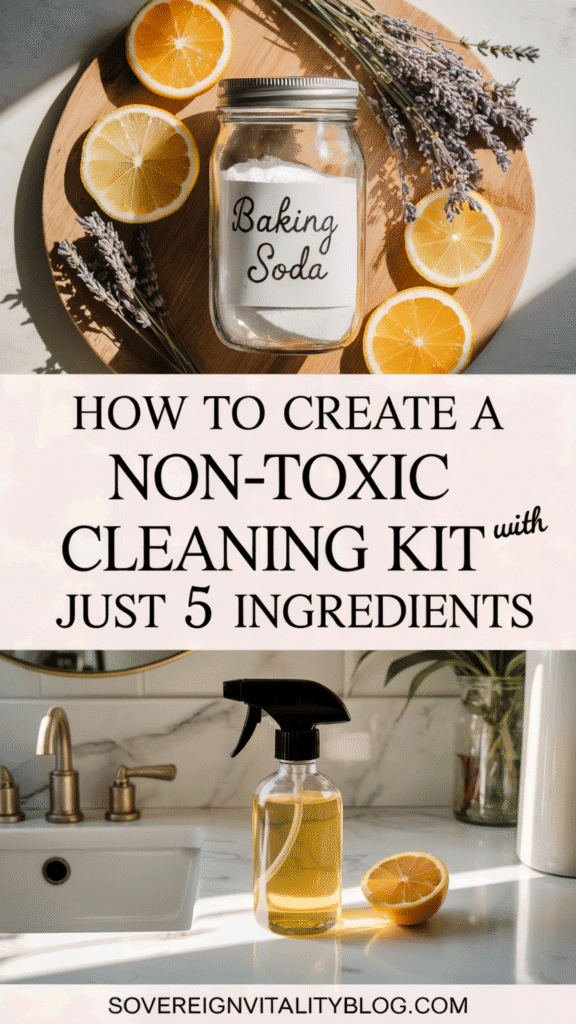
I get it. I was there, too. But trust me, once I realized the power of simplicity, everything changed.
Today, my entire cleaning routine revolves around just five simple ingredients, all safe, effective, and eco-friendly. This blog post breaks down the 5 ingredients that can help you build a non-toxic home cleaning routine you can do in one weekend.
Before We Begin: Can These 5 Ingredients Really Disinfect?
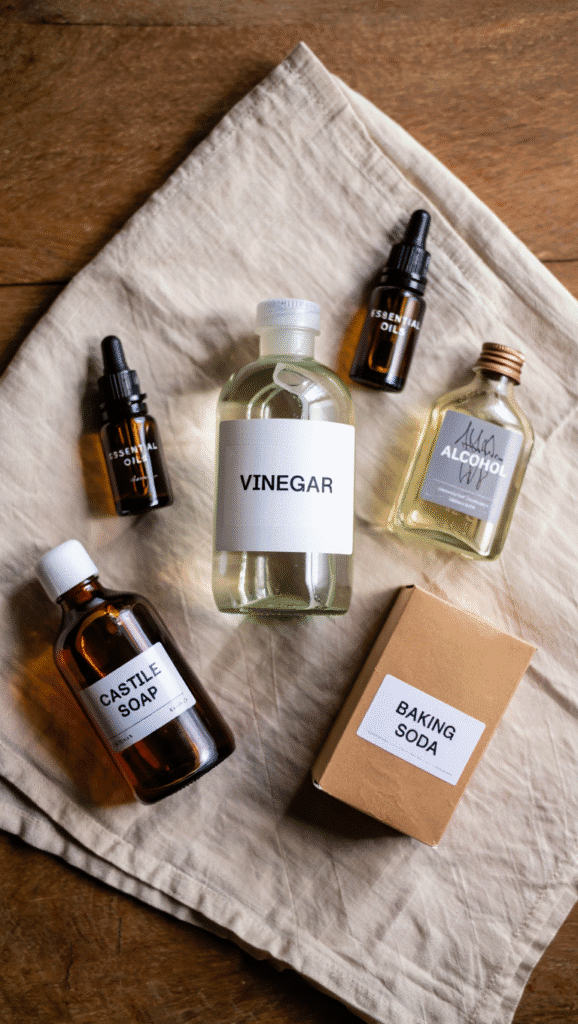
Let’s address one of the biggest misconceptions right away: Can homemade cleaning products effectively disinfect without harsh chemicals like bleach?
The short answer is yes. But understanding how natural disinfectants work can boost your confidence in making the switch.
Alcohol vs. Hydrogen Peroxide
- Alcohol (Isopropyl or Vodka): An excellent disinfectant due to its ability to break down proteins in germs. I love alcohol-based cleaners for everyday surfaces like counters, electronics, and doorknobs. It’s quick to evaporate and leaves no residue behind.
- Hydrogen Peroxide: Great for porous surfaces and tackling biofilms like grout and tile. It gently foams away bacteria and mold. Just keep in mind that peroxide solutions degrade when exposed to sunlight, so always store them in opaque bottles.
Essential Oils: More Than Just Fragrance
Tea tree, lavender, eucalyptus, and lemon essential oils have antimicrobial properties. They’re effective helpers—not just lovely scents. However, be mindful—while essential oils are wonderful, they’re not suitable for all surfaces and can irritate pets and young children in concentrated amounts. Always dilute properly and consult your vet if you’re uncertain.
Steam Cleaning and UV Technology (Optional Extras)
Steam cleaning is a fabulous method because it disinfects surfaces using only water vapor—no chemicals at all. It’s particularly wonderful on floors, upholstery, and bathroom fixtures. UV wands and air purifiers are modern tools that can add extra peace of mind, especially in flu season, though they aren’t strictly necessary.
Now that you see you can indeed disinfect safely, let’s get down to your simple, effective cleaning kit!
The 5 Core Ingredients for Your Non-Toxic Cleaning Kit
Keeping things simple has transformed not just my cabinets, but my mindset. Here’s exactly what you need for your DIY cleaning recipes, and why each earns its place in your home:
1. Baking Soda
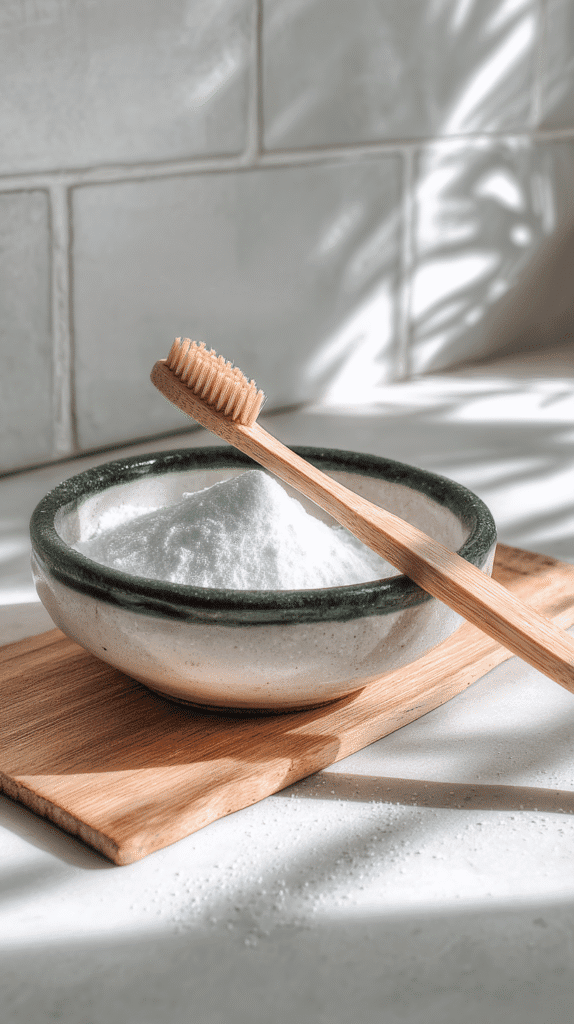
Think of baking soda as your gentle, versatile abrasive. It’s amazing at scrubbing away grime without scratching surfaces. It also naturally neutralizes odors.
- Best uses: Soft scrubs, deodorizing carpets and refrigerators, unclogging drains, and laundry stain removal.
- Why it works: Its mild alkalinity breaks down dirt and grease effectively.
2. White Vinegar
White vinegar is your natural powerhouse for cleaning, deodorizing, and mildly disinfecting. Despite its strong smell at first, it dissipates quickly, leaving surfaces genuinely fresh.
- Best uses: Windows, mirrors, bathrooms, kitchens (great for countertops and appliances).
- Why it works: Vinegar’s acidity dissolves mineral buildup, cuts through grease, and inhibits mold growth. Remember, avoid vinegar on natural stone or waxed wood surfaces to prevent damage.
3. Castile Soap
Derived from natural oils, castile soap is gentle, biodegradable, and incredibly versatile. It’s a staple in my cleaning kit because it bridges the gap between gentleness and effectiveness.
- Best uses: Dish soap, laundry detergent, floor cleaner, body wash.
- Why it works: It’s plant-based, cuts through grime easily, and rinses clean without residue. Remember to rinse thoroughly to avoid slippery surfaces.
4. Alcohol (Isopropyl or Vodka)
Alcohol is essential for quick-drying disinfectant sprays. It’s one of my favorites because it cleans beautifully and evaporates without streaking.
- Best uses: Glass cleaner, electronic disinfectant, surface sprays, high-touch areas.
- Why it works: Alcohol disrupts the cell walls of germs and bacteria, effectively neutralizing them.
5. Essential Oils
Essential oils bring gentle fragrance and extra antimicrobial properties into your natural cleaning solutions. My favorites include lemon, tea tree, lavender, and eucalyptus.
- Best uses: Enhancing the scent of your homemade cleaners, boosting their antimicrobial power.
- Why it works: Many oils have natural antibacterial and antifungal properties, offering added protection against germs.
DIY Multipurpose Cleaner Recipe (My Everyday Hero)
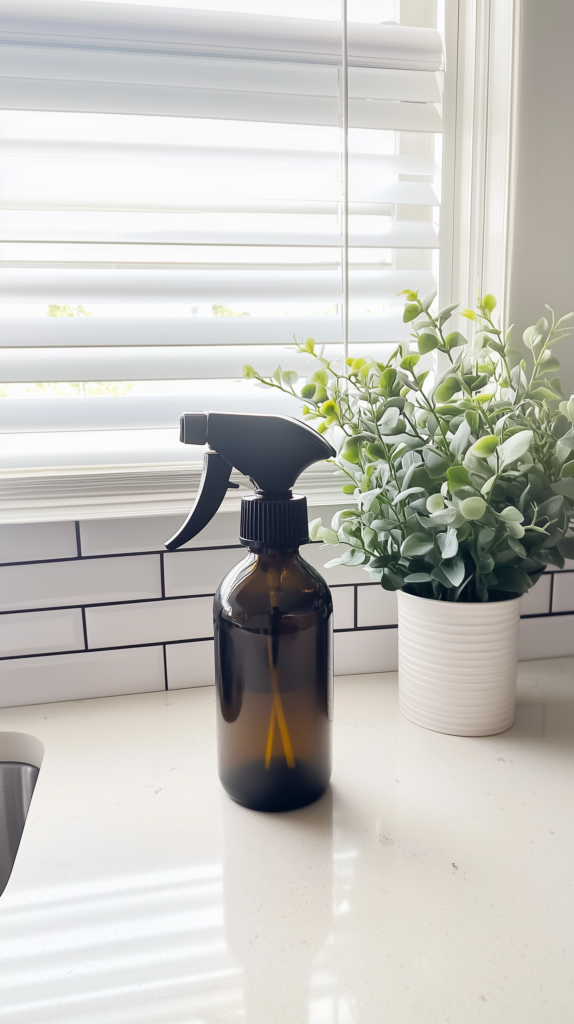
Ready to get started immediately? Here’s my go-to homemade multipurpose cleaner:
- 1 cup distilled water
- 1 cup white vinegar
- 1 teaspoon castile soap (optional, adds extra cleaning power)
- 15 drops lemon or tea tree essential oil
Combine ingredients in a glass spray bottle. Shake gently before use. Perfect for counters, sinks, and general surfaces.
DIY Homemade Disinfectant Spray
For disinfecting high-touch surfaces like doorknobs and remote controls, here’s my simple recipe:
- 1 cup isopropyl alcohol (70% or higher)
- ½ cup distilled water
- 20 drops tea tree or lavender essential oil
Mix in a spray bottle, shake well, spray, and let air dry.
For more specific recipes that use these 5 ingredients and actually work, explore this guide on natural cleaners that outperform conventional brands.
Basic Storage & Labeling Tips
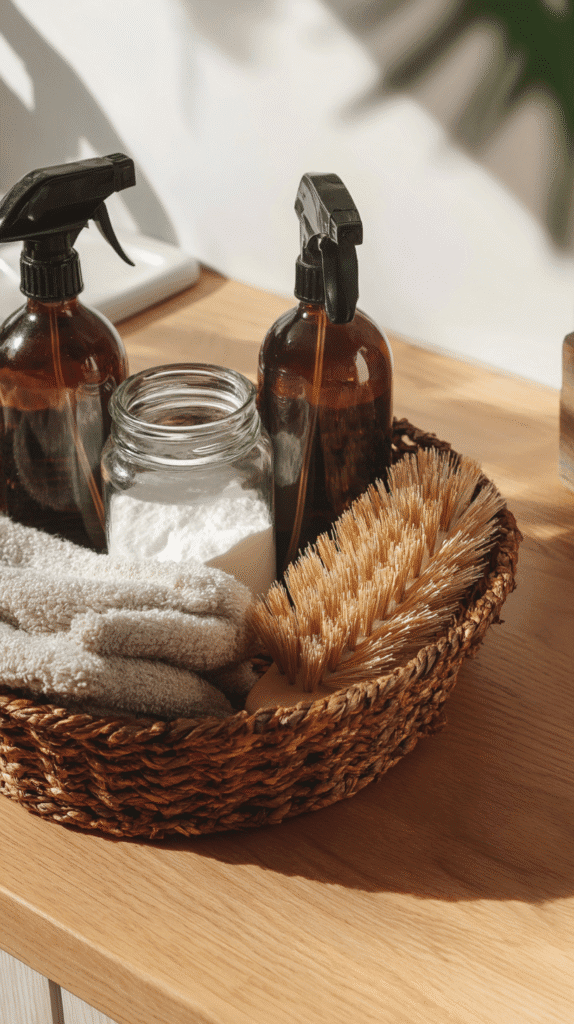
Organizing your cleaning supplies is key to making your routine easy and enjoyable. Here’s how I keep mine simple and accessible:
- Glass Spray Bottles: Amber or cobalt glass bottles protect essential oils from UV degradation. I label each clearly with the cleaner’s name and ingredients.
- Expiration Dates: Homemade cleaners generally last well, but peroxide-based formulas should be labeled and replaced every few months to ensure effectiveness.
- Easy Access: Store your cleaning kit in an easily accessible basket or caddy. Mine lives neatly under the sink for quick grab-and-go use.
- Safety First: Clearly label products and store them safely away from children and pets, even though they’re non-toxic. Clarity ensures peace of mind.
A Cleaner Home, a Clearer Mind
Creating a non-toxic home isn’t complicated, it’s empowering. Simplifying your cleaning routine with these five ingredients clears mental clutter too. Now, cleaning day is genuinely calming rather than stressful. It can even be part of a holistic sunday reset routine.
If you’re just starting your journey or feeling unsure, pick just one recipe to try. Maybe the DIY multipurpose cleaner—once you see how beautifully it works, I promise you’ll feel inspired to go further.
Your home deserves to be a sanctuary, a safe, calm place free from unnecessary toxins. You deserve the peace of mind that comes with knowing exactly what’s in your products and that they truly work.
Step by step, cleaner by cleaner, you can reclaim your space and your health.

